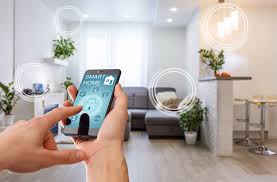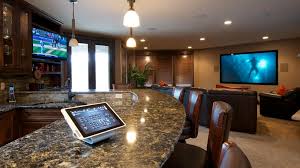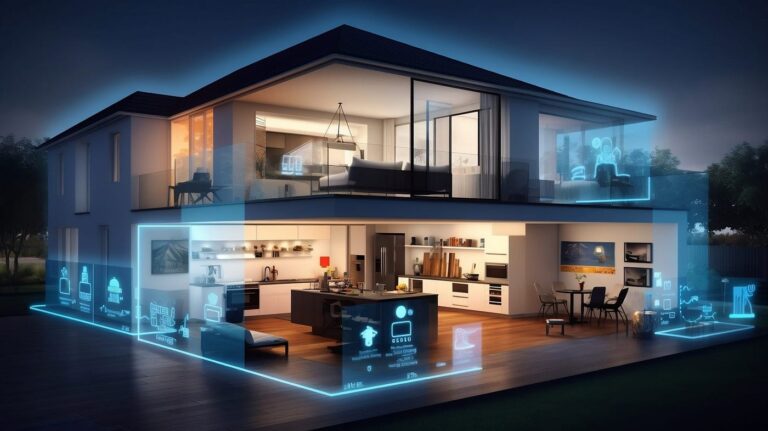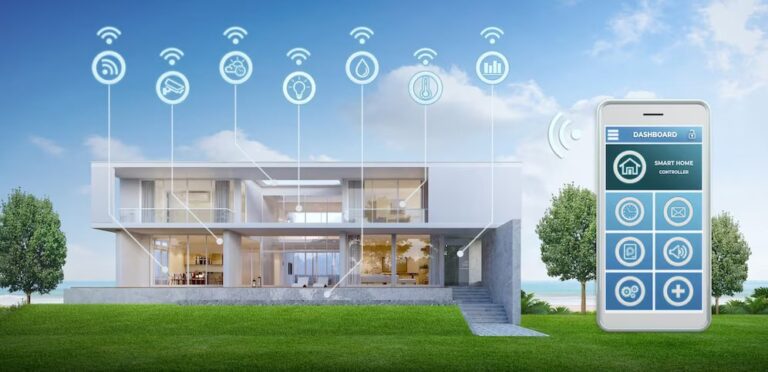Home Automation The Future of Smart Living
Home Automation
Home automation, often referred to as a “smart home,” is transforming the way we live, offering unprecedented levels of convenience, efficiency, and control. By integrating technology into everyday household functions, home automation allows homeowners to manage lighting, heating, security, and entertainment systems with a tap on their smartphone or a simple voice command. As we move further into the digital age, the concept of a fully automated home is no longer a futuristic dream but a tangible reality for many households worldwide.
The rise of home automation is driven by advancements in the Internet of Things (IoT), artificial intelligence (AI), and wireless communication. These technologies enable devices to communicate with each other, learn from user behavior, and adapt to preferences, creating a seamless and personalized living experience. From controlling your thermostat remotely to automating your morning coffee routine, the possibilities are vast and growing. This article explores the core components, benefits, challenges, and future trends of home automation, providing a comprehensive guide for anyone looking to embrace this innovative technology.
What is Home Automation?
At its core, home automation involves the use of technology to control and automate household systems and appliances. These systems can include lighting, climate control, security cameras, door locks, and even kitchen appliances. The goal is to enhance comfort, improve energy efficiency, and increase security while reducing the need for manual intervention.
A typical home automation system consists of three main components:
- Devices and Sensors: These are the physical components, such as smart lights, thermostats, or motion detectors, that perform specific tasks or collect data about the environment.
- Hub or Controller: A central hub or controller connects all devices, allowing them to communicate and operate as a cohesive system. Popular hubs include Amazon Echo, Google Nest Hub, and Samsung SmartThings.
- Software or App: Most home automation systems are controlled through a mobile app or voice assistant, enabling users to monitor and manage devices remotely.
Home automation systems can be customized to suit individual needs, whether you want to automate a single room or your entire home. They can operate on schedules, respond to triggers (like motion or temperature changes), or be controlled manually for maximum flexibility.
Benefits of Home Automation
The adoption of home automation is growing rapidly due to its numerous benefits. Below are some of the key advantages that make smart homes an attractive option for modern homeowners.
1. Convenience and Comfort
Imagine waking up to a home that has already adjusted the thermostat to your preferred temperature, opened the blinds to let in natural light, and started brewing your coffee—all without you lifting a finger. Home automation makes daily routines effortless by allowing you to control multiple devices from a single interface. Voice assistants like Amazon Alexa or Google Assistant further simplify tasks, enabling hands-free operation with simple commands like, “Turn on the living room lights” or “Play my favorite playlist.”
2. Energy Efficiency
One of the most significant benefits of home automation is its potential to save energy. Smart thermostats, such as the Nest Learning Thermostat, learn your schedule and adjust heating or cooling to optimize energy use. Smart lighting systems can turn off lights in unoccupied rooms or dim them based on natural light levels. These small adjustments can lead to substantial savings on utility bills while reducing your environmental footprint.
3. Enhanced Security
Home automation enhances security through features like smart locks, video doorbells, and surveillance cameras. You can monitor your property in real-time, receive alerts about suspicious activity, and even grant temporary access to visitors via your smartphone. For example, a smart doorbell like Ring allows you to see and speak to someone at your door, whether you’re at home or halfway across the world. Automated lighting can also simulate occupancy, deterring potential intruders when you’re away.
4. Cost Savings
While the initial investment in home automation can be significant, the long-term savings often outweigh the costs. Energy-efficient devices reduce utility bills, and smart maintenance systems can alert you to issues like water leaks or HVAC malfunctions before they become costly repairs. Additionally, some insurance companies offer discounts for homes equipped with smart security systems, further offsetting the upfront expense.
5. Customization and Scalability
Home automation systems are highly customizable, allowing you to start small and expand over time. You might begin with a smart speaker and a few smart bulbs, then gradually add devices like smart plugs, cameras, or automated blinds. This scalability makes home automation accessible to a wide range of budgets and preferences.
Popular Home Automation Devices
The market is flooded with innovative devices designed to make your home smarter. Here are some of the most popular categories and examples of devices that can transform your living space.
- Smart Lighting: Brands like Philips Hue and LIFX offer bulbs that can change color, dim, or turn on/off via an app or voice command. These lights can be programmed to create ambiance or save energy.
- Smart Thermostats: Devices like Ecobee and Nest adjust your home’s temperature based on your habits, weather conditions, and remote inputs, ensuring comfort and efficiency.
- Smart Security Systems: Products like Arlo cameras, Ring doorbells, and August smart locks provide robust security features, from motion detection to remote access control.
- Smart Speakers: Amazon Echo, Google Nest, and Apple HomePod serve as central hubs for controlling other devices while offering voice-activated assistance.
- Smart Appliances: From refrigerators that track groceries to robotic vacuum cleaners like iRobot Roomba, smart appliances simplify household chores.
When choosing devices, consider compatibility with your existing system or hub. Many devices support multiple platforms (e.g., Alexa, Google Home, or Apple HomeKit), but it’s wise to check before purchasing to ensure seamless integration.
Challenges of Home Automation
While home automation offers numerous benefits, it’s not without challenges. Understanding these potential drawbacks can help you make informed decisions when setting up your smart home.
1. High Initial Costs
The cost of smart devices, hubs, and installation can be a barrier for some homeowners. A single smart thermostat can cost $100-$250, and outfitting an entire home with smart lighting, security, and appliances can quickly add up. However, prices are gradually decreasing as the technology becomes more widespread.
2. Compatibility Issues
Not all devices work seamlessly together, especially if they’re from different manufacturers. Choosing a universal hub or sticking to a single ecosystem (e.g., Apple HomeKit or Samsung SmartThings) can mitigate this issue, but it requires careful planning.
3. Security and Privacy Concerns
Smart devices are connected to the internet, making them potential targets for hackers. Weak passwords or outdated firmware can leave your system vulnerable. Additionally, some devices collect data on user habits, raising privacy concerns. To minimize risks, use strong passwords, enable two-factor authentication, and regularly update device firmware.
4. Learning Curve
Setting up and managing a home automation system can be daunting, especially for those unfamiliar with technology. While most systems are designed to be user-friendly, troubleshooting connectivity issues or configuring complex routines may require technical knowledge.
The Future of Home Automation
The future of home automation is bright, with emerging technologies poised to make smart homes even smarter. Artificial intelligence is playing a significant role, enabling devices to learn from user behavior and anticipate needs. For example, AI-powered systems could predict when you’re likely to arrive home and adjust the thermostat or lighting accordingly.
Another exciting development is the integration of renewable energy sources, such as solar panels, with home automation systems. Smart energy management systems can optimize the use of solar power, reducing reliance on the grid and lowering costs. Additionally, advancements in 5G technology will enhance device connectivity, enabling faster and more reliable communication between devices.
Voice assistants are also evolving, becoming more intuitive and capable of handling complex commands. In the coming years, we can expect greater interoperability between devices, thanks to standards like Matter, a universal protocol that aims to simplify smart home connectivity. This will make it easier for consumers to mix and match devices from different brands without worrying about compatibility.
Getting Started with Home Automation
If you’re new to home automation, starting small is the best approach. Begin with a single device, like a smart bulb or plug, and a compatible hub or voice assistant. Experiment with basic automations, such as scheduling lights to turn on at dusk or setting up a “goodnight” routine that locks doors and turns off lights. As you become more comfortable, you can expand your system with additional devices and more complex routines.
Before purchasing, research devices to ensure they meet your needs and are compatible with your preferred platform. Consider your budget, the size of your home, and the specific tasks you want to automate. Professional installation services are available for those who prefer a hands-off approach, but many devices are designed for easy DIY setup.
Conclusion
Home automation is revolutionizing the way we interact with our living spaces, offering unparalleled convenience, efficiency, and security. While challenges like cost and compatibility exist, the benefits of a smart home—energy savings, enhanced security, and personalized comfort—make it a worthwhile investment for many. As technology continues to evolve, home automation will become even more accessible and integrated, paving the way for a future where smart homes are the norm.
Whether you’re a tech enthusiast or simply looking to simplify your daily routine, home automation has something to offer. By starting small and gradually expanding your system, you can create a smart home that’s tailored to your lifestyle. Embrace the future of living—your smart home awaits!






